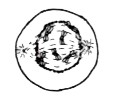The organizatin of shoot apex into tunica and corpus is determined largely on the basis of
(a) Regions of meristematic activity
(b) Planes of cell division
(c) Rate of shoot tip growth
(d) Rate of cell division
Regions of meristematic activity
Planes of cell division
Rate of shoot tip growth
Phase of cell division
The correct Answer is:B
To solve the question regarding the organization of the shoot apex into tunica and corpus, we need to analyze the options provided and understand the underlying concepts.
1. Understanding the Question: The question asks about the basis for the organization of the shoot apex into tunica and corpus. This refers to a specific theory in plant anatomy known as the tunica-corpus theory.
2. Identifying Key Terms:
- Tunica: The outer layer of cells in the shoot apex.
- Corpus: The inner layer of cells in the shoot apex.
- Meristematic Activity: Refers to the regions where cells are actively dividing.
- Planes of Cell Division: The orientation in which cells divide (e.g., horizontal, vertical).
- Rate of Cell Division: How quickly cells are dividing in a given area.
3. Analyzing the Options:
- (a) Regions of meristematic activity: While this is relevant, it does not specifically determine the organization into tunica and corpus.
- (b) Planes of cell division: This relates to how cells divide but does not directly address the organization into tunica and corpus.
- (c) Rate of shoot tip growth: This is more about overall growth rather than the specific organization of cell layers.
- (d) Rate of cell division: This option directly relates to how the tunica and corpus are formed based on the rate at which cells are dividing in these regions.
4. Conclusion: Based on the analysis, the organization of the shoot apex into tunica and corpus is determined largely by the rate of cell division. Therefore, the correct answer is (d) Rate of cell division.
Final Answer:
(d) Rate of cell division
---
- Tunica: The outer layer of cells in the shoot apex.
- Corpus: The inner layer of cells in the shoot apex.
- Meristematic Activity: Refers to the regions where cells are actively dividing.
- Planes of Cell Division: The orientation in which cells divide (e.g., horizontal, vertical).
- Rate of Cell Division: How quickly cells are dividing in a given area.
- (a) Regions of meristematic activity: While this is relevant, it does not specifically determine the organization into tunica and corpus.
- (b) Planes of cell division: This relates to how cells divide but does not directly address the organization into tunica and corpus.
- (c) Rate of shoot tip growth: This is more about overall growth rather than the specific organization of cell layers.
- (d) Rate of cell division: This option directly relates to how the tunica and corpus are formed based on the rate at which cells are dividing in these regions.
(d) Rate of cell division
Topper's Solved these Questions
- BOOK - CENGAGE BIOLOGY ENGLISHCHAPTER - ANATOMY OF FLOWERING PLANTS EXERCISE - ASSERTION-REASONING QUESTIONS14videos
ANATOMY OF FLOWERING PLANTS
- BOOK - CENGAGE BIOLOGY ENGLISHCHAPTER - ANATOMY OF FLOWERING PLANTS EXERCISE - ARCHIVES38videos
ANATOMY OF FLOWERING PLANTS
- BOOK - CENGAGE BIOLOGY ENGLISHCHAPTER - ANIMAL KINGDOMEXERCISE - Archives34videos
ANIMAL KINGDOM
Similar Questions
Arrange the following in correct sequence from root tip.
A) Region of maturation
B) Region of meristematic activity
C) Region of elongation
D) Root hair zoneView SolutionAccretionary growth is due to
(a) Reserve cells
(b) Meristematic cells
(c) Embryonic cells
(d) Differentiated cellsView SolutionName the plant hormones responsible for the following
(a) elongation of cells (b) growth of stem
(c ) promotion of cell division (d) falling of senescent leavesView Solution(A)_____ In plants is largely restricted to specialized regions of active cell division, called (B)______.
View SolutionM-Phase in humans lasts
(a) 90% of the total cell division duration
(b) 60% of the total cell division duration
(c) 96% of the total cell division duration
(d) 5 % of the total cell division durationView SolutionQuiescent centre is found in
(a) Shoot apex
(b) Root apex
(c) Both a and b
(d) Meristematic tissueView SolutionAbscisic acid controls
(a) Cell elongation and cell wall formation
(b) Shoot elongation
(c) Leaf fall and dormancy
(d) Cell divisionView SolutionIn a longitudinal section of a root, starting from the tip upward, the four zones occur in the following order
(a) Cell division, cell enlargement, cell maturation, root cap
(b) Cell division cell matuation, cell enlargement, root cap
(c) Root cap, cell division, cell enlargement, cell maturation
(d) Root cap, cell division, cell maturation, cell enlargementView SolutionThe central region of root apex containing less active cells is known as
(a) Plerome
(b) Dermatogen
(c) Periblem
(d) Quiescent zoneView SolutionThe given diagram shows a stage during mitotic division in an animal cell:

Name the type of cell division that occurs during:
A. Growth of a shoot
B. Formation of pollen grains.View Solution

